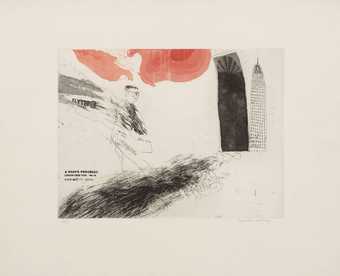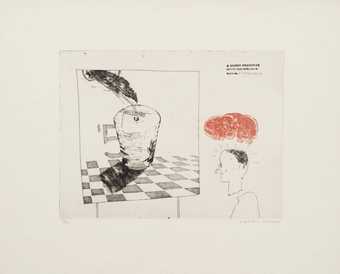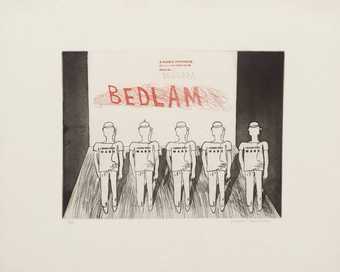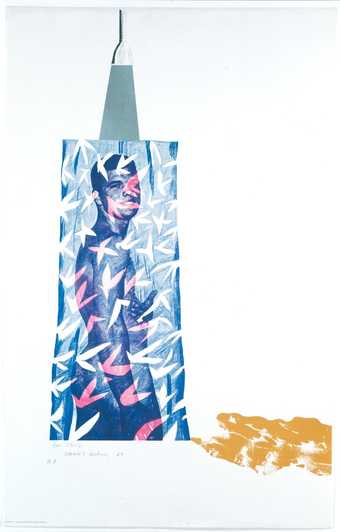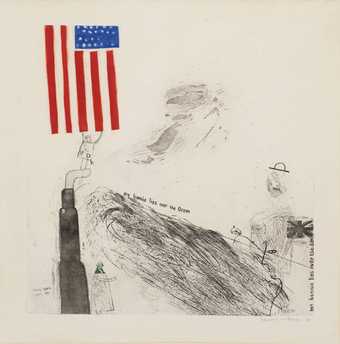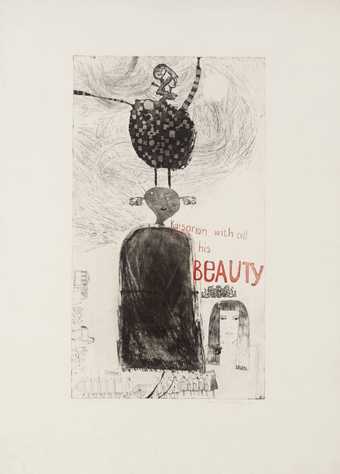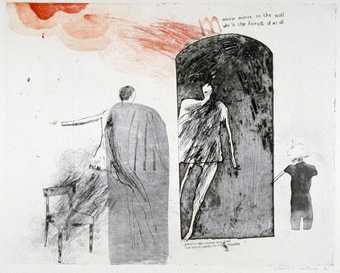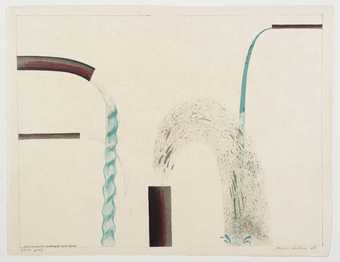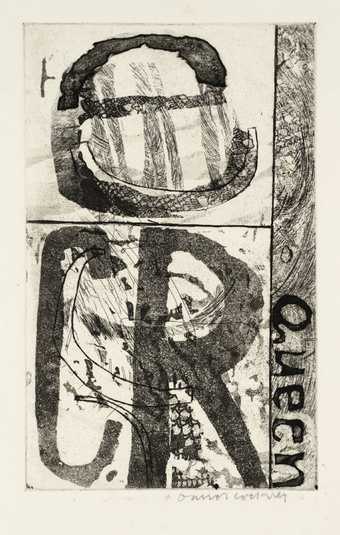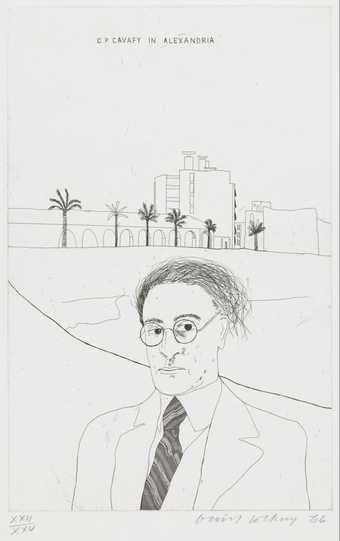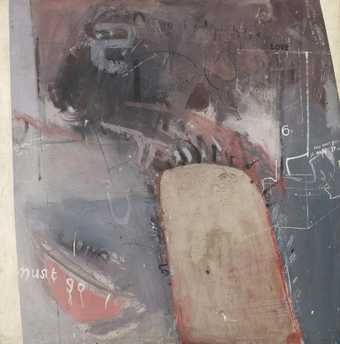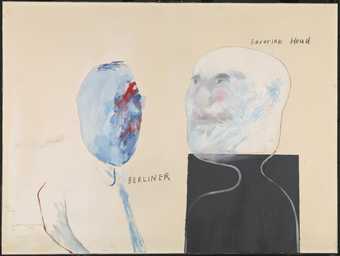
On loan
Musée Granet (Aix-en-Provence, France): David Hockney
- Artist
- David Hockney born 1937
- Medium
- Chalk on paper
- Dimensions
- Support: 404 × 512 mm
- Collection
- Tate
- Acquisition
- Presented by Klaus Anschel in memory of his wife Gerty 2004
- Reference
- T11898
Summary
This drawing in charcoal by David Hockney is related to his major early painting Doll Boy 1960–1 (private collection, reproduced in Stangos, fig.18, p.49). The drawing shows a stylised figure, which has been placed on the right side of the page, leaving the left side empty. A geometrical shape, coloured a dense black, looms over it. The proportions of the figure are exaggerated: an outsized body with spindly limbs. A line of buttons adorns its bulky torso. The figure’s head leans awkwardly to the right, as if pushed by the weight of the black shape. Between the shape and the boy is the word ‘dollboy’. The word ‘Queen’ is inscribed along the base of the figure’s torso.
Hockney produced this drawing while a postgraduate student at the Royal College of Arts, London (1959–62). Tate also holds the related study in oils for Doll Boy (T12882), produced at the same time. The naïve almost crude style of both studies and the final painting has echoes of Outsider Art, especially the work of Jean Dubuffet (1901–85), whom Hockney admired (Stangos, p.67).
In the 1960s Hockney began to make works that celebrated his sexuality, yet, perhaps because homosexuality was not decriminalised in Britain until 1967, these works make reference to it in a veiled way. The artist used cryptic words or phrases to hint at their meaning (such as the use in this work of the gay slang term ‘queen’). The title Dollboy derives from lyrics from the song Living Doll written by Lionel Bart and popularised in the period by Cliff Richard (born 1940). Hockney explained:
Doll Boy was a reference to the pop singer Cliff Richard, who was very attractive, very sexy. I’m not a great pop music fan, I wasn’t then and I’m not now. But I’m a lover of music and a lover of songs and I like singing. Cliff Richard was a very popular singer and I used to cut out photographs of him from newspapers and magazines and stick them up around my little cubicle at the Royal College of Art, partly because other people used to stick up girl pin-ups, and I thought, I’m not going to do that, can’t do that, and there’s something just as sexy, and I stuck them up. He had a song in which the words were, ‘She’s a real live walking talking living doll’ [sic], and he sang it rather sexily. The title of this painting is based on that line. He’s referring to some girl, so I changed it to a boy.
(Quoted in Stangos, p.63.)
Hockney produced several works in the early 1960s that refer to his crush on Cliff Richard, including ECR (Cliff Richard) circa 1960–2 (P11495). The painting We Two Boys Together Clinging (Arts Council, London), inspired by a poem by Walt Whitman (1819–92), is also linked to a newspaper headline about a mountaineering incident that caught Hockney’s eye ‘Two Boys Cling to Cliff All Night’, which suggested to him an allusion to the singer (Stangos, p.68).
Further reading:
Nikos Stangos, ed., David Hockney By David Hockney, London 1976.
Ulrich Luckhardt and Paul Melia, David Hockney: A Drawing Retrospective, exhibition catalogue, Royal Academy of Arts, London 1995, reproduced p.42.
Marco Livingstone, David Hockney, London 1996.
Alice Sanger
May 2009
Does this text contain inaccurate information or language that you feel we should improve or change? We would like to hear from you.
Explore
- abstraction(8,615)
-
- from recognisable sources(3,634)
-
- figure(2,270)
- inscriptions(6,664)
-
- title of work(308)
You might like
-
David Hockney 1. The Arrival
1961–3 -
David Hockney 2a. The Gospel Singing (Good People) (Madison Square Garden)
1961–3 -
David Hockney 7. Disintegration
1961–3 -
David Hockney 8a. Bedlam
1961–3 -
David Hockney Cleanliness is Next to Godliness
1964 -
David Hockney Myself and my Heroes
1961 -
David Hockney My Bonnie Lies Over the Ocean
1961–2 -
David Hockney Kaisarion and All his Beauty
1961 -
David Hockney Mirror, Mirror on the Wall
1961 -
David Hockney Water Pouring into Swimming Pool, Santa Monica
1964 -
David Hockney Pacific Mutual Life
1964 -
David Hockney Queen
1961 -
David Hockney Portrait of Cavafy in Alexandria
1966 -
David Hockney The Third Love Painting
1960 -
David Hockney The Berliner and the Bavarian
1962

